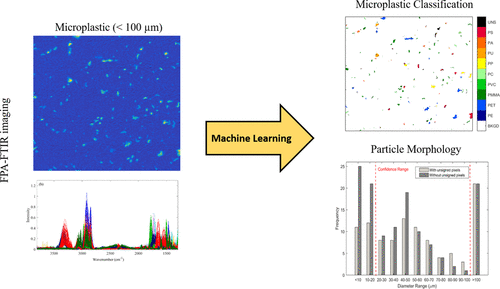当前位置:
X-MOL 学术
›
Anal. Chem.
›
论文详情
Our official English website, www.x-mol.net, welcomes your
feedback! (Note: you will need to create a separate account there.)
Classification and quantification of microplastic (< 100 µm) using FPA-FTIR imaging system and machine learning.
Analytical Chemistry ( IF 6.7 ) Pub Date : 2020-09-18 , DOI: 10.1021/acs.analchem.0c01324 Vitor H da Silva 1 , Fionn Murphy 1 , José M Amigo 2, 3 , Colin Stedmon 4 , Jakob Strand 1
Analytical Chemistry ( IF 6.7 ) Pub Date : 2020-09-18 , DOI: 10.1021/acs.analchem.0c01324 Vitor H da Silva 1 , Fionn Murphy 1 , José M Amigo 2, 3 , Colin Stedmon 4 , Jakob Strand 1
Affiliation

|
Microplastics are defined as microscopic plastic particles in the range from few micrometers and up to 5 mm. These small particles are classified as primary microplastics when they are manufactured in this size range, whereas secondary microplastics arise from the fragmentation of larger objects. Microplastics are widespread emerging pollutants, and investigations are underway to determine potential harmfulness to biota and human health. However, progress is hindered by the lack of suitable analytical methods for rapid, routine, and unbiased measurements. This work aims to develop an automated analytical method for the characterization of small microplastics (<100 μm) using micro-Fourier transform infrared (μ-FTIR) hyperspectral imaging and machine learning tools. Partial least squares discriminant analysis (PLS-DA) and soft independent modeling of class analogy (SIMCA) models were evaluated, applying different data preprocessing strategies for classification of nine of the most common polymers produced worldwide. The hyperspectral images were also analyzed to quantify particle abundance and size automatically. PLS-DA presented a better analytical performance in comparison with SIMCA models with higher sensitivity, sensibility, and lower misclassification error. PLS-DA was less sensitive to edge effects on spectra and poorly focused regions of particles. The approach was tested on a seabed sediment sample (Roskilde Fjord, Denmark) to demonstrate the method efficiency. The proposed method offers an efficient automated approach for microplastic polymer characterization, abundance numeration, and size distribution with substantial benefits for method standardization.
中文翻译:

使用FPA-FTIR成像系统和机器学习对微塑料(<100 µm)进行分类和定量。
微观塑料定义为微观塑料颗粒,范围从几微米到最大5毫米。这些小颗粒在此尺寸范围内制造时,被分类为主要的微塑料,而次要的微塑料则来自较大物体的破碎。微塑料是普遍出现的污染物,目前正在进行调查以确定对生物区系和人体健康的潜在危害。但是,由于缺乏适用于快速,常规和无偏测量的合适分析方法,进展受到了阻碍。这项工作旨在使用微傅立叶变换红外(μ-FTIR)高光谱成像和机器学习工具,开发一种用于表征小型微塑料(<100μm)的自动分析方法。对偏最小二乘判别分析(PLS-DA)和类比软独立建模(SIMCA)模型进行了评估,并应用了不同的数据预处理策略对全球生产的9种最常见的聚合物进行分类。还对高光谱图像进行了分析,以自动量化颗粒的丰度和大小。与SIMCA模型相比,PLS-DA具有更好的分析性能,具有更高的灵敏度,灵敏度和更低的分类错误。PLS-DA对光谱的边缘效应和粒子聚焦区域较不敏感。该方法在海底沉积物样品(丹麦罗斯基勒峡湾)上进行了测试,以证明该方法的有效性。拟议的方法提供了一种有效的自动化方法,用于微聚合物的表征,丰度计算,
更新日期:2020-10-21
中文翻译:

使用FPA-FTIR成像系统和机器学习对微塑料(<100 µm)进行分类和定量。
微观塑料定义为微观塑料颗粒,范围从几微米到最大5毫米。这些小颗粒在此尺寸范围内制造时,被分类为主要的微塑料,而次要的微塑料则来自较大物体的破碎。微塑料是普遍出现的污染物,目前正在进行调查以确定对生物区系和人体健康的潜在危害。但是,由于缺乏适用于快速,常规和无偏测量的合适分析方法,进展受到了阻碍。这项工作旨在使用微傅立叶变换红外(μ-FTIR)高光谱成像和机器学习工具,开发一种用于表征小型微塑料(<100μm)的自动分析方法。对偏最小二乘判别分析(PLS-DA)和类比软独立建模(SIMCA)模型进行了评估,并应用了不同的数据预处理策略对全球生产的9种最常见的聚合物进行分类。还对高光谱图像进行了分析,以自动量化颗粒的丰度和大小。与SIMCA模型相比,PLS-DA具有更好的分析性能,具有更高的灵敏度,灵敏度和更低的分类错误。PLS-DA对光谱的边缘效应和粒子聚焦区域较不敏感。该方法在海底沉积物样品(丹麦罗斯基勒峡湾)上进行了测试,以证明该方法的有效性。拟议的方法提供了一种有效的自动化方法,用于微聚合物的表征,丰度计算,











































 京公网安备 11010802027423号
京公网安备 11010802027423号